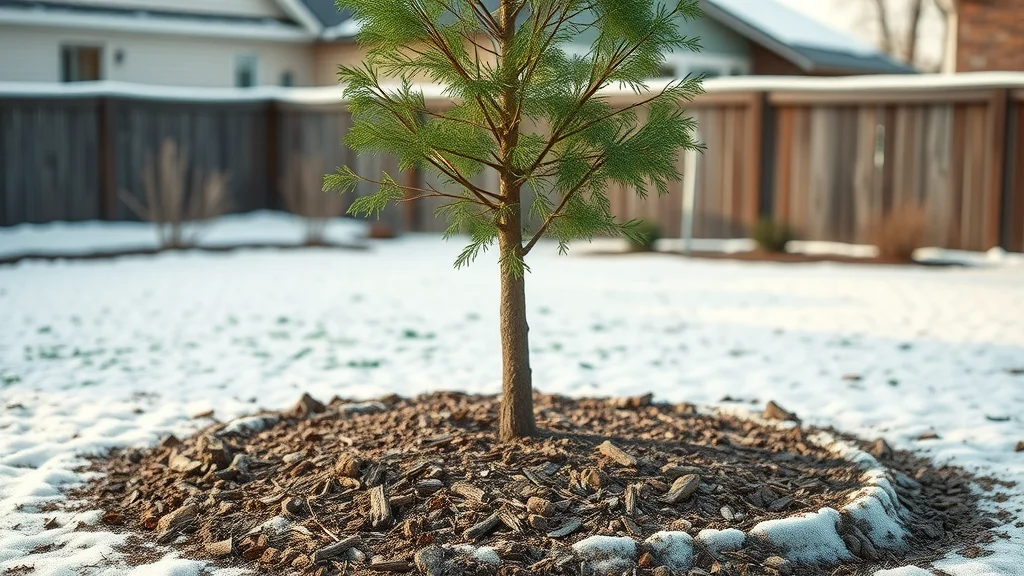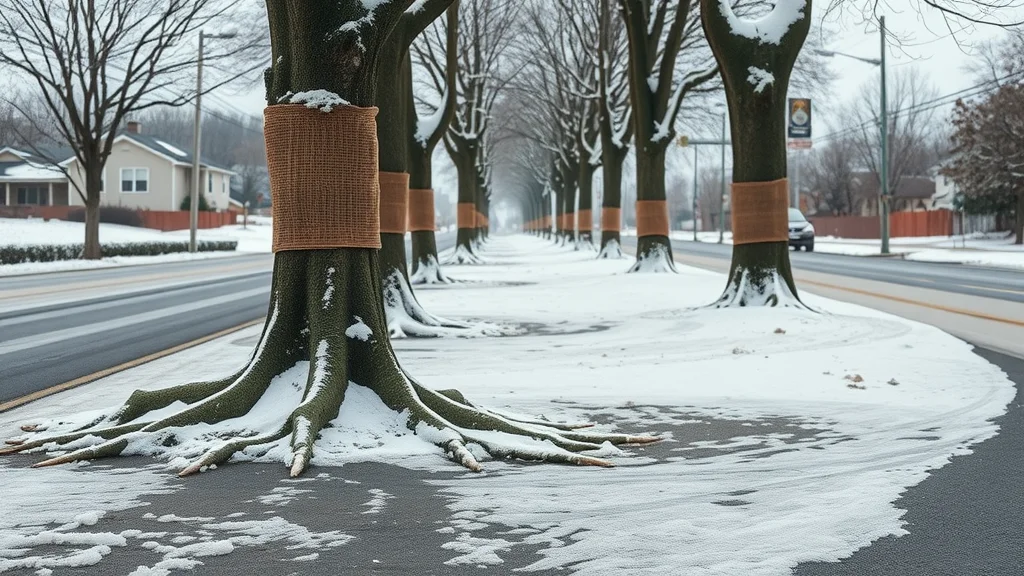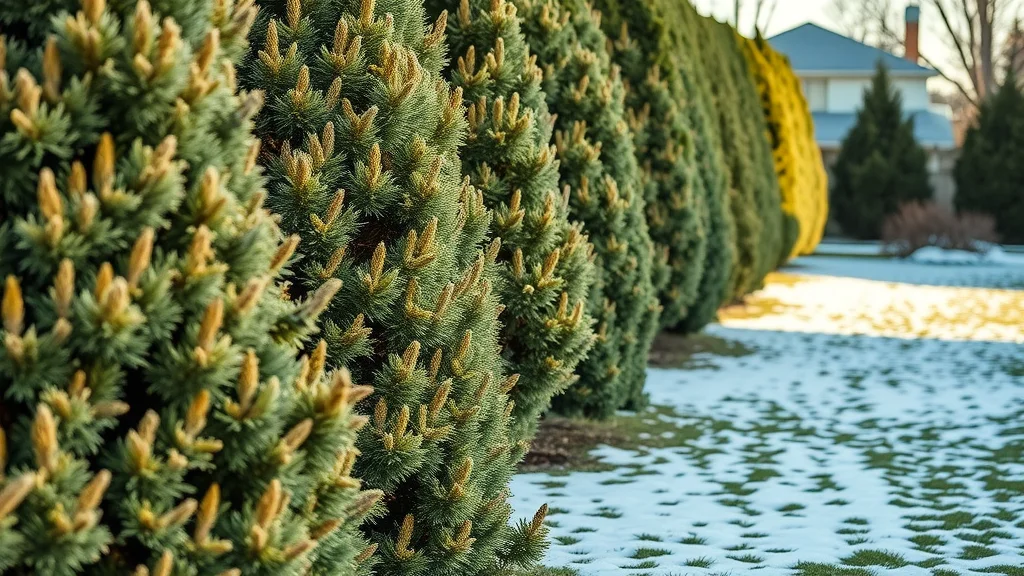Did you know that more than 60% of tree damage occurs during winter, and most of it is entirely preventable with proper winter tree maintenance? Every year, harsh winter conditions silently threaten your trees—risking bark splitting, moisture loss, and even permanent damage. But with the right knowledge and simple preventative action, you can protect your trees before frost bites. This comprehensive guide gives you step-by-step advice, pro tips, and real-world strategies to keep your trees strong, healthy, and ready to thrive come spring.
Startling Facts About Winter Tree Maintenance That Homeowners Overlook
"More than 60% of tree damage occurs during winter, most of it preventable with proper winter tree maintenance."
When the temperatures drop and snow starts to fall, homeowners often focus on shoveling driveways or keeping pipes from freezing—but overlook a critical part of their landscape: their trees. Winter tree maintenance is not just about survival; it's a primary way to protect property value, manage potential liabilities (think falling branches), and ensure that prized shade trees and evergreens rebound with vigor in the spring. Neglecting tree care during the winter months often leads to unexpected expenses, from storm cleanup to total tree loss or costly removal services. Even mature, healthy trees are at risk from snow and ice, frigid winds, or rock salt exposure. Young trees, sensitive species, or those planted recently are especially vulnerable and require elevated protection during the dormant, colder months to guard against frost cracks and moisture depletion.
Proactive winter tree care minimizes cold damage, boosts spring growth, and prevents expensive headaches down the line. With the right timing—especially late winter for pruning—you can give your trees an edge over winter's hidden threats. As you'll discover, simple techniques like mulching the tree base, watering during dry spells, and shielding roots from salt are all key strategies. In short, each step you take before and during winter lays the foundation for healthier, more resilient trees all year round.
- Winter tree maintenance prevents cold damage and promotes healthier spring growth.
- Neglecting winter tree care leads to costly repairs and tree loss.
- Elevated protection is needed for young trees and sensitive species.

What You'll Learn About Winter Tree Maintenance
Whether you’re a seasoned gardener or a first-time homeowner, this guide breaks down the essential winter tree maintenance techniques and tips for all skill levels. Our expert-backed strategies will help you avoid common pitfalls—from improper pruning to overusing rock salt—and equip you with actionable steps to support the health and beauty of your trees, even in the harshest winter months.
- Essential steps for comprehensive winter tree maintenance and care
- How to protect trees and shrubs from snow and ice
- Common mistakes in pruning, watering, and fertilizing before frost
- Expert insights on avoiding moisture loss and bark splitting
Understanding How Trees and Shrubs Adapt in Winter
Trees and shrubs have evolved remarkable adaptations to withstand freezing weather, but even these natural defenses need human help during extreme winter conditions. When late fall approaches, trees begin their dormancy cycles, slowing their metabolic processes and conserving energy. This “sleep mode” allows them to endure colder months with reduced photosynthetic activity and limited nutrient uptake.
Root system health becomes essential in winter since roots continue to absorb water whenever the ground isn't frozen. Moisture loss is a subtle, serious threat: winter wind and winter sun can dry out branches and evergreen foliage, often before any outward signs appear. Ice crystals can also form within plant cells, risking tissue damage. A healthy, undisturbed root system and a well-mulched tree base are vital in retaining moisture and buffering against rapid temperature swings that cause bark splitting or frost cracks, especially in young tree trunks.
How Trees and Shrubs Prepare for Winter and Survive Freezing Conditions
The survival game for your trees and shrubs ramps up as frosts arrive. Most deciduous trees shed their leaves, reducing surface area and lowering water loss. Dormancy cycles kick in, slowing cellular activity and halting new growth. Deep root systems help anchor trees and store reserves for the dormant period. To minimize moisture loss, the tree base and surrounding soil can be protected with a layer of mulch, which insulates roots against severe cold and fluctuating thaw cycles that can damage your tree.
Winter watering is still crucial in areas where snow cover is insufficient; even dormant trees can suffer from dehydration. Moisture loss often goes unnoticed until injury appears in the early spring—brown needles on evergreens, cracked bark, or stunted growth. Not only does winter tree maintenance involve protecting visible branches and leaves, but it’s also about creating the best subsurface conditions for root health, organic matter, and water retention during the lowest temperatures.
- Dormancy cycles in trees and shrubs
- Moisture loss prevention strategies
- The significance of root system health in winter

| Timing | Task | Safety/Tips |
|---|---|---|
| Early Winter | Mulch base, protect young trees, assess for damage | Check for pests, use 2-3 inches of mulch, avoid touching trunk directly |
| Late Winter | Prune trees, finish wrapping, prep for spring feeding | Prune during dormancy for minimal stress, clean tools, avoid fertilizing too early |
Top Winter Tree Maintenance Techniques for Healthy Trees
Building a strong winter tree maintenance routine sets your landscape up for long-term vitality, whether you’re caring for mature oaks or newly-planted maples. Focus areas such as strategic pruning, deep watering, proper mulching, and timely fertilization not only shield plants through the winter season but can also preempt damage your tree might otherwise sustain. Use these expert-backed strategies to fortify your trees against common cold-weather hazards.
Even after leaves have fallen, attentive winter tree care ensures you’re prepared for sudden changes: a quick freeze, a heavy blanket of snow, or rock salt migrating toward tree roots. Each maintenance technique is essential for a different reason, but when combined, they build a protective shield around your trees and shrubs through the harshest months.
Prune Trees in Late Winter: The Safest and Most Effective Approach
Pruning might seem counterintuitive during the coldest months, but late winter is actually the ideal time for this critical tree care step. When trees are fully dormant, disease organisms are less active, and sap loss is minimized—reducing the risk of introducing pests or causing damage that impedes spring recovery. Professional arborists and tree care experts recommend removing dead, damaged, or crossing branches before new growth begins, focusing on both shape and structural integrity.
Always use clean, sharp tools and cut just beyond the branch collar to encourage rapid healing. Avoid pruning during freeze-thaw cycles or immediately after snow storms, as this can cause branch splitting or leave wounds exposed to harsh weather. Timely pruning not only prevents future broken limbs due to snow and ice but also prepares your trees for robust spring expansion. Ignoring the late winter pruning window is one of the most common mistakes that homeowners make—costing them healthy growth and sometimes the entire tree.
- Timing and methods for winter tree pruning
- Avoiding moisture loss and disease introduction

Winter Watering: How and Why to Water Trees in Cold Months
Despite chilly conditions, trees can still experience drought stress—especially during extended dry spells with little rain or snow cover. Winter watering is crucial when the ground isn’t frozen solid. Newly planted trees and shallow-rooted species require extra hydration to combat moisture loss caused by bright winter sun and persistent wind. Water trees and shrubs during midday on warmer days so moisture has time to be absorbed before the temperature drops overnight, and avoid watering if the soil is saturated or frozen, as this can promote fungal issues.
Recognizing drought stress early can save a tree’s life. Look for dry, brittle twigs, or early browning on evergreens as telltale signs. Use a slow, deep soak to encourage roots to grow downward, strengthening your plant’s resilience to winter conditions. Overwatering is just as dangerous—roots deprived of oxygen in waterlogged soil can weaken the tree and stunt spring regrowth.
- Best practices for winter watering
- Recognizing drought-stressed trees and shrubs
Mulching and Fertilizing Young Trees Before Frost
For young trees, proper mulching is one of the best forms of winter protection. Apply a 2-4 inch thick layer of organic mulch—such as wood chips or shredded leaves—around the tree base, making sure to keep mulch a few inches away from touching the trunk itself. This insulates surface roots, retains soil moisture, and evens out the impact of freeze-thaw cycles common in winter months. For fertilization, avoid heavy applications just before winter; instead, use slow-release formulas or add composted organic matter in late fall to gradually boost your tree’s natural resources and root health as spring nears.
This simple maintenance step can mean the difference between a thriving, vigorous sapling and one that fails to leaf out come spring. Mulched and fertilized trees are better equipped to retain moisture and resist the damaging effects of snow and ice, harsh winter sun, and even rock salt exposure from nearby driveways or streets. Remember: heavy-handed fertilizing during dormancy can damage your tree rather than help it.
- Selecting the right mulch
- Proper fertilization to boost winter resilience

Protecting Trees From Snow, Ice, and Rock Salt Damage
Winter brings more than just picturesque snow—it also unleashes potentially harmful elements on your trees, such as damaging snow accumulation, destructive ice build-up, and corrosive rock salt from de-icing practices. The structural effects of heavy snow on tree branches and cumulative stress from repeated ice storms can result in split limbs or toppled trees. At the same time, road salt used for melting ice can leach into the soil, harming tree roots and even causing trunks to crack or discolor.
By recognizing these threats and implementing targeted winter tree care measures, homeowners can dramatically reduce winter injury risk and promote healthier, more beautiful landscapes in the spring. Both techniques for physical protection and smart landscaping habits play critical roles in this process.
Preventative Tree Care Against Ice Build-up and Snow Accumulation
Heavy, wet snow and ice pose unique risks to both mature trees and young trees still developing their structure. One of the most effective tree care techniques is regularly shaking snow off the branches of evergreens and delicate shrubs—using a broom, not your hands, to gently dislodge built-up snow. Avoid forceful movements or trying to remove ice from branches, as this can cause cracking or damage due to their vulnerability during cold temperatures. Where snow and ice are mild, it may be safest to leave them undisturbed, as they can offer insulating protection from even colder wind temperatures.
Install supports for heavy branches, especially on young or newly-planted trees. Wrap vulnerable tree trunks with burlap to prevent frost cracks and shield bark from direct rock salt spray. Monitoring weather changes and acting promptly after a snowstorm can mean the difference between costly tree loss and a quick, simple fix.
- Techniques to minimize snow and ice harm
- When to shake snow off vs. leave it
Mitigating Rock Salt Impact on Roots and Tree Trunks
Rock salt used for de-icing roads and walkways is a hidden hazard to your landscape. When snow and ice melt, salt-laden water can travel to the tree base, contaminating the root zone and causing dehydration, leaf browning, and long-term decline. Even established trees may show signs of salt damage: early leaf drop, discolored bark on the tree trunk, or stunted spring growth.
To protect your trees, create physical barriers like burlap wraps or plastic shields along road-facing trunks and use alternative de-icing practices such as sand or calcium magnesium acetate near trees and shrubs. If damage occurs, flush the soil with plain water in early spring to help leach excess salt out of the root zone. Avoid piling salty snow near the tree base, and keep a careful eye on the first signs of stress—like wilting or discolored leaves come early spring.
- Recognizing and treating salt damage
- Best barriers and alternative de-icing practices

Winter Tree Maintenance for Young Trees and Newly Planted Trees
Young trees, especially those planted in late fall or early spring, face unique winter hazards—rapid temperature changes, fluctuating soil moisture, brittle stems, and higher vulnerability to wind and sun damage. Winter tree maintenance for these saplings is non-negotiable: a few extra precautions can safeguard years of growth and ensure lasting landscape beauty.
Common mistakes—such as improper staking, skipping tree wraps, or using the wrong mulch—can leave young trees susceptible to winter injury, bark splitting, or even death during deep freezes. Protecting your investment starts with understanding these needs and providing consistent care all winter long.
Extra Steps for Young Trees: Staking, Wrapping, and Monitoring
To shield tender tree trunks from winter sun and wind, wrap with commercial tree wrap or burlap from the base up to the first main branches. Stake loosely enough to allow some natural movement but firmly enough to prevent the tree from tipping or breaking under snow and ice weight. Regularly monitor for signs of stress—such as cracking, bark splitting, or wilting shoots—throughout winter and into early spring, when symptoms may first appear.
Frost cracks, in particular, are a major concern for young trees and recently planted saplings. They occur when warmed bark is rapidly cooled, causing splits up and down the trunk. Mulching and wrapping are both effective ways to even out temperature fluctuations. Remember to remove or loosen wraps each spring to prevent pest buildup or bark softening, and use a layer of mulch to prevent excessive moisture loss from exposed roots.
- Protecting the tree trunk against frost cracks
- How to correctly wrap and stake trees
- Identifying stress in young trees and shrubs

Common Mistakes in Winter Tree Maintenance and How to Avoid Them
- Ignoring late winter pruning windows: Delay in pruning can allow disease to establish before the growing season, causing branch dieback and poor spring shape.
- Overwatering or underwatering during cold snaps: Monitor soil and water only when ground isn’t frozen; overwatering deprives roots of air, while underwatering leads to moisture loss and root stress.
- Applying fertilizer incorrectly: Applying too much fertilizer before frost can push late growth that’s vulnerable to freeze damage; opt for slow-release or composted organic matter.
- Overusing rock salt near trees and shrubs: Excessive salt runoff leads to root dehydration, bark injuries, and long-term decline—use physical barriers and salt alternatives when possible.
Expert Quotes on the Importance of Winter Tree Maintenance
"Winter is the most vulnerable season for our trees, and targeted tree care now means thriving trees come spring." — Arborist Emily Field
Demonstration of winter tree maintenance techniques such as pruning, mulching, and using protective wraps, with close-ups on tools and healthy trees in a snowy neighborhood.
People Also Ask About Winter Tree Maintenance
Are you supposed to trim trees in winter?
Yes, late winter is widely regarded as the best and safest time to prune trees. During this dormant period, wounds heal faster, there's less sap flow, and pests or disease organisms are less likely to invade pruning cuts. Pruning dead, damaged, or poorly positioned branches at this time boosts tree health and shapes growth for the next season—but avoid pruning during extreme cold snaps or thaw cycles, as this can cause bark injury.
How to keep trees alive during winter?
To keep trees and shrubs alive in winter, focus on providing a healthy start with late fall watering, adding mulch around the tree base, physically protecting trunks from wind and sun, and avoiding excess fertilizer. Clear away snow and ice safely, watch for salt damage, and monitor even dormant trees for signs of stress. For young or recently planted trees, extra staking and wrapping may be required to withstand winter conditions and minimize moisture loss.
Should I fertilize my trees before winter?
Avoid fertilizing right before frost unless it's a slow-release, organic matter supplement. Heavy fertilizer at this time may encourage late growth that’s susceptible to freezing, resulting in weakened trees come spring. The best practice is to apply compost or a balanced, slow-release formula in early fall or very early spring, giving roots a gentle nutritional boost without causing tender new shoots.
What steps does a tree take to prepare for winter?
As temperatures drop, trees enter dormancy—a slowed metabolic state that conserves energy and halts active growth. They shed leaves to reduce water loss, move carbohydrates into roots, and thicken bark to protect against cold. Trees with deep roots and healthy soil fare best during cold months, and a layer of mulch or protection from wind and salt can make the difference between thriving and surviving.
Comprehensive Winter Tree Maintenance Checklist
- Assess all trees and shrubs for existing damage
- Perform late winter pruning as needed
- Apply mulch to roots of young trees
- Wrap tree trunks of vulnerable species
- Water during dry or thaw periods
- Use protective barriers against road salt
- Monitor for snow and ice damage throughout winter
Frequently Asked Questions About Winter Tree Maintenance
-
Can I plant new trees in late winter?
Yes, you can plant trees in late winter or very early spring, as long as the ground is workable—not frozen—and soil moisture is adequate. Late winter planting allows roots to establish before the growing season begins, but water thoroughly and mulch well. -
How do I protect evergreen shrubs during the winter?
Wrap shrubs loosely with burlap to shield them from wind and salt spray, and water well in late fall. Avoid heavy snow buildup by gently brushing it away, and use mulch to maintain consistent root temperatures. -
When should I call a tree care professional?
Contact a certified arborist if your tree has major storm damage, severe cracking, obvious disease, or you are unsure how to prune properly. Proper diagnosis and safe removal of risks can only be guaranteed by trained tree care professionals.
Key Takeaways for Optimal Winter Tree Maintenance
- Regular winter tree maintenance is essential for tree health and property value.
- Special care should be given to young and newly planted trees for the greatest results.
- Understanding the impact of snow, ice, and rock salt protects your landscape investment.
Expert arborists demonstrate the ideal time and methods to prune trees, prep for spring, and prevent cold damage during late winter.
Get Ahead This Winter: Master Winter Tree Maintenance Now
If you want your trees to thrive—not merely survive—through the next cold snap, put these winter tree maintenance steps into action today. Grow your landscaping expertise—call 203-271-7991 or visit TreeGuardianNews.com to subscribe.
To enhance your understanding of winter tree maintenance, consider exploring the following resources:
-
“Winter Tree Care Tips” by the Highlands Ranch Metro District offers practical advice on mulching, pruning, and watering during the colder months. (highlandsranch.org)
-
“DIY Winter Tree Care” from the Nashville Tree Conservation Corps provides a comprehensive guide on protecting young trees, proper pruning techniques, and the benefits of mulching. (nashvilletreeconservationcorps.org)
These resources offer valuable insights to help you effectively protect and maintain your trees throughout the winter season.
 Add Row
Add Row  Add
Add 




Write A Comment